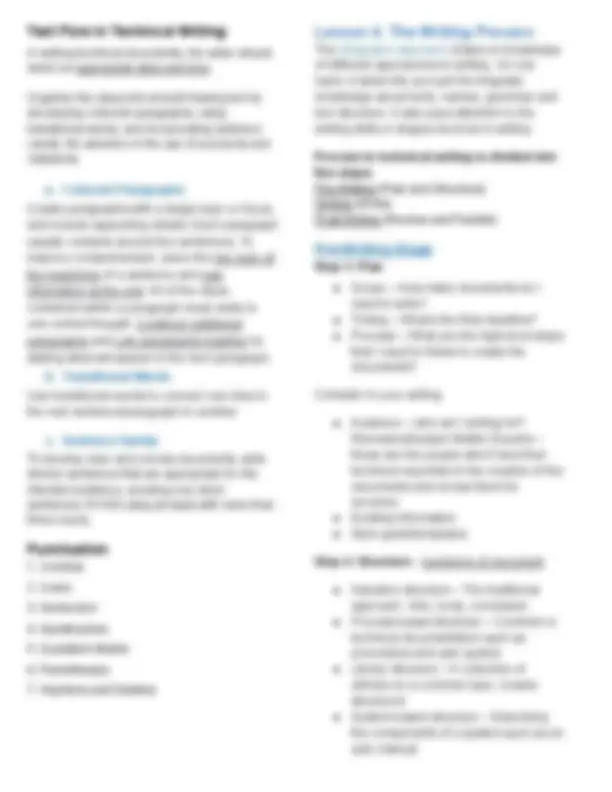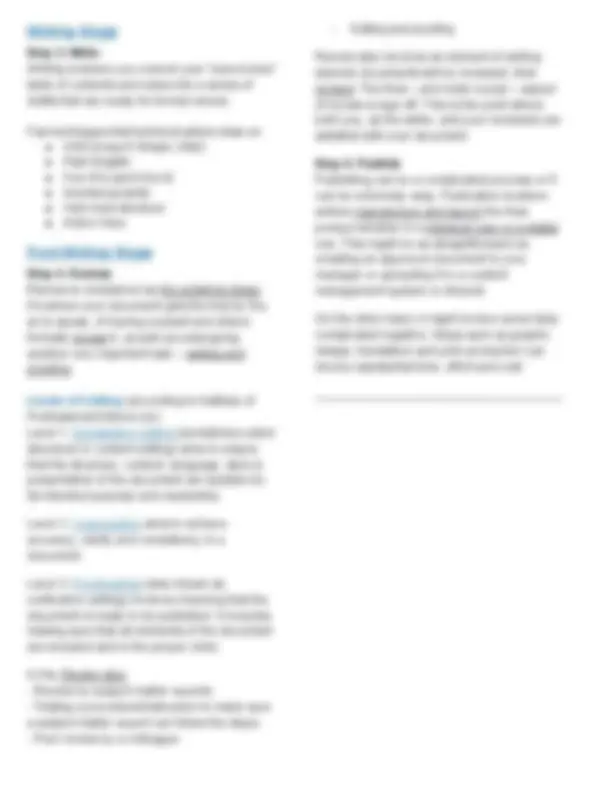




Study with the several resources on Docsity

Earn points by helping other students or get them with a premium plan


Prepare for your exams
Study with the several resources on Docsity

Earn points to download
Earn points by helping other students or get them with a premium plan
Community
Ask the community for help and clear up your study doubts
Discover the best universities in your country according to Docsity users
Free resources
Download our free guides on studying techniques, anxiety management strategies, and thesis advice from Docsity tutors
Technical Writing Lesson 1: What is Technical Writing? Lesson 2: Five Traits of Technical Writing Lesson 3: Grammar Review Lesson 4: The Writing Process
Typology: Study notes
1 / 4

This page cannot be seen from the preview
Don't miss anything!



Technical writing is communication written for and about business and industry, focusing on products and services: how to manufacture, market, manage them, deliver them & use them. Technical writing is Resume, Instructional manual, Memo and meeting agendas. It does not focus on poetic images, describe personal experiences, or report. Not a: Literature, Essay, journalism. It is direct, informative, clear, and concise language written specifically for an identified audience. The content must be accurate and complete with NO exaggerations. To deliver the intended message, the text must be objective and persuasive WITHOUT being argumentative. Developing technical documents that meet these requirements and standard guidelines is time consuming. Technical writing is written in the work environment (work hours) for:
**- Supervisors - Colleagues
● Communication is not just from one emitter to one receiver but rather from one to many. ● Oral Communication may fall short when we need to transmit the information technical documents require. ● Students will write essays while working on their college degrees and even be asked to write essays on their job application. However, once the job begins, essays end. ● The goal of technical writing is to enable readers to use an innovation or understand a process or concept.
mandatory. The most important criteria for effective technical writing is clarity. Using the Questions Checklist as a prewriting tool: 5W and 1H (What, who, where, when, why and How)
importance in technical writing. It is a tool for the readers to use to accomplish whatever job they are doing. In contrast to traditional essays, effective technical writing uses short words and short sentences. ● Achieved short words ● Achieved short sentences ● Avoid redundancy ● Avoid Prepositional phrases ● Avoid passive voice
way the text looks on the page. Highlighting techniques: ● Graphics (Tables & Figures) ● White space ● Boldface text ● Headings and subheadings ● Italics ● Underlining ● Varied Font sizes ● Varied Font types ● Bullets ● Numbered lists
audience fails to understand the text, you have failed to communicate! a. High Tech Peers know as much about a subject matter as you. They have the same job title, same education, same years of experience. Use acronyms and abbreviations. b. Low Tech Peers who work in your company know something about the subject matter. They may not have the same job title, education, years of experience, or level of expertise. Know acronyms and abbreviations with meaning. c. Lay Readers are your customers. They are completely out of the loop. Doesn’t understand abbreviations and acronyms, and needs follow-up explanations.
must be correct, whether grammatically, mathematically, electronically, etc. Future professionals should understand the importance of proofreading. ● Use the computer’s spell check ● Let it sit ● Use peer evaluations ● Read it aloud ● Read it backward
Grammar is the systematic description of the way words work together to form a coherent language. To achieve clarity and accuracy, you need to know both grammar (as a description of the way words work together) and the conventions of usage. a. Parallel Structure b. Subjects and Verbs c. Active and Passive Voice d. Cases of Pronouns e. Pronoun and Antecedent Agreement f. Compound Words g. Capitalization h. Numbers as words i. That and Which
Step 3: Write Writing is where you convert your “bare-bones” table of contents and notes into a series of drafts that are ready for formal review. Few techniques that technical writers draw on: ● KISS (Keep It Simple, Silly!) ● Plain English ● Five W’s (and One H) ● Inverted pyramid ● Verb-noun structure ● Active Voice
Step 4: Review Review is considered as the polishing stage. It’s where your document gets the trial by fire, so to speak, of having yourself and others formally review it, as well as undergoing another very important task – editing and proofing. Levels of Editing (according to Institute of Professional Editors Ltd.) Level 1: Substantive editing (sometimes called structural or content editing) aims to ensure that the structure, content, language, style & presentation of the document are suitable for its intended purpose and readership. Level 2: Copyreading aims to achieve accuracy, clarity and consistency in a document. Level 3: Proofreading (also known as verification editing) involves checking that the document is ready to be published. It includes making sure that all elements of the document are included and in the proper order. In the Review step: